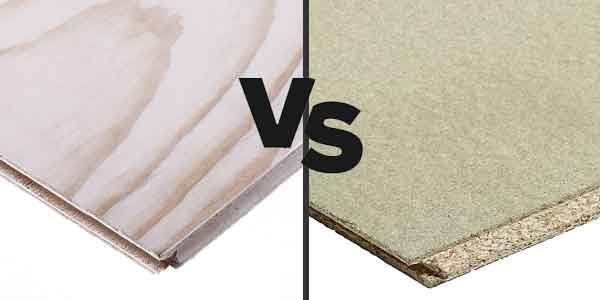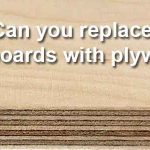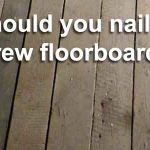In this article we will be looking at replacing chipboard flooring with plywood. Including why you might want to do this, pros and cons, and the different options available.
Chipboard flooring is one of the most common types of floorboards used in modern properties. It usually comes in sheets of 600 x 2400mm, and the thickness of these sheets is generally 18 – 22mm thick.

Chipboard is popular for several reasons, but mainly because it is low cost, and easy to fit. It can also be purchased as a standard chipboard or a water-resistant variety.
With that said, it is not without its problems. Some of the main issues can be seen below:
- When nailed, chipboard flooring can creak quite badly.
- If standard chipboard gets wet, it deteriorates.
- Water resistant chipboard is just splash proof. It’s not waterproof, so eventually it will also deteriorate.
- Once fitted, chipboard flooring can be difficult to remove, or access below.
- It can’t be used as a finished floor, as it is not aesthetically pleasing.
If you are replacing chipboard flooring, one of your options is plywood. Plywood is also a manufactured sheet wood. However, it is generally more robust and durable. This is due to the way it is manufactured.
Chipboard, also known as particle board, is made by combining glues and resins, with wood flakes and chippings. Once the wood chippings are completely coated in the resin, it is compressed into sheets.
In comparison, plywood is made from thin sheets of wood. These are glued together and pressed at high temperatures, to form a strong solid sheet material.
Pros of replacing chipboard flooring with ply
As we have already mentioned, the production of each material is different. Therefore, the finished product has different characteristics. In this section, we will be looking at the main advantages of replacing chipboard with plywood.
- It is a stronger product – Over time plywood is likely to last longer than chipboard.
- It is more water resistant – Due to its structure, it will take longer to deteriorate when in contact with moisture. A standard interior plywood will hold up much better than a standard chipboard.
The same is true for water resistant versions. You can buy exterior plywood that is very water resistant and suitable for outdoor use. Marine plywood can even be boiled for 72+ hours before it begins to deteriorate.
On the other hand, water resistant chipboard is nowhere near as resistant to moisture and should never be used outside. - Plywood creaks less underfoot – Whilst both products can creak if they are nailed, in my experience chipboard is worse. Obviously, the solution to either boards creaking, is to screw them rather than nailing them. Nailing is more common because it is often cheaper and easier. Also, the job can be done extremely quickly if you are using a first fix nail gun
- Wider variety – Plywood comes in more sizes and thicknesses, as well as several more different varieties. Lower end interior plywood flooring (softwood) is only slightly more expensive than standard chipboard.
Hardwood and tropical plywood are higher quality, and both are more water-resistant.
Then you also have things like marine plywood, and decorative faced plywood, which are far better quality, with the latter being suitable for finished flooring.
Cons of replacing chipboard with Plywood
- More expensive – In pretty much all cases, it is more expensive. This is the main reason chipboard is more common, it is simply a more affordable product. This is particularly true, when compared with any higher quality plywood.
- T&G plywood flooring is less readily available – Go to any builder’s yard, timber merchant, or big DIY chain and most will stock tongue and groove chipboard flooring. It is far less likely you will find tongue and groove plywood.
You can obviously lay standard plywood. However, this will likely require more cutting (more work). Also, because there is no tongue and groove, you will need to add noggins under all unsupported edges (more work again). This is required, otherwise you could end up with steps between boards.
These are the main issues. Its simply just more expensive, and harder to get hold of.
Conclusion
To conclude, it is completely acceptable to replace chipboard flooring with plywood. Whether it is the best choice, will depend on the individual circumstances you are facing.
If this is your own home, then plywood is certainly a better product, so for a slightly higher price, you will definitely get a better-quality sub floor. You may just need to shop around to get the best price, and you may need to order your tongue and groove plywood online.




